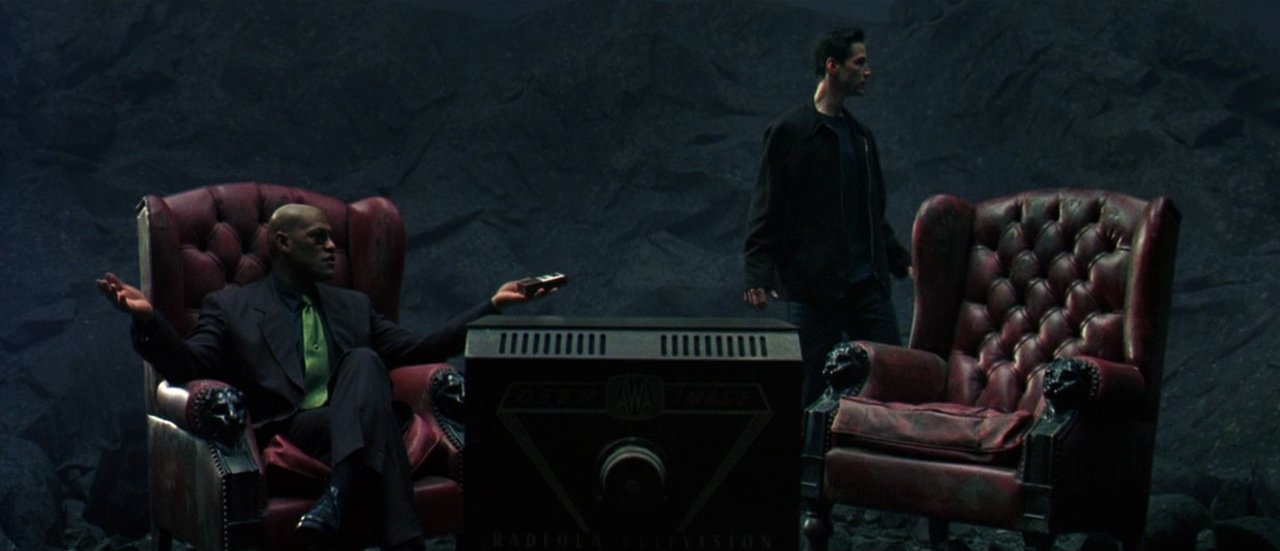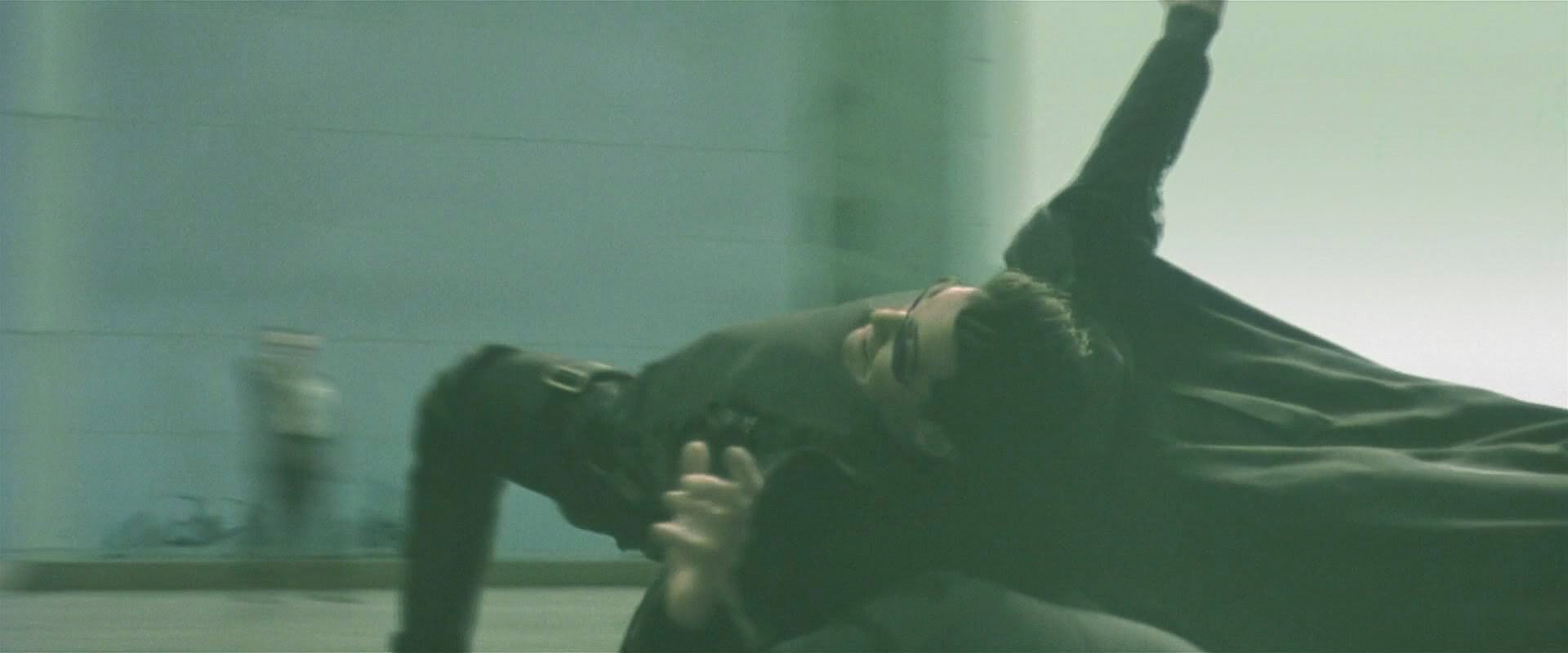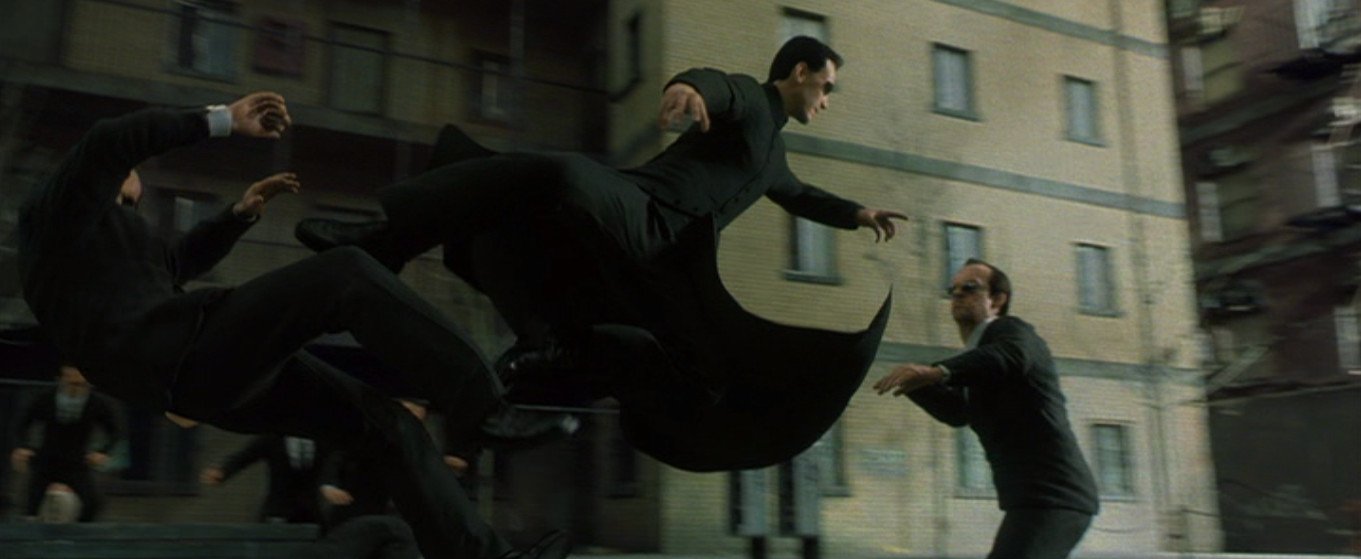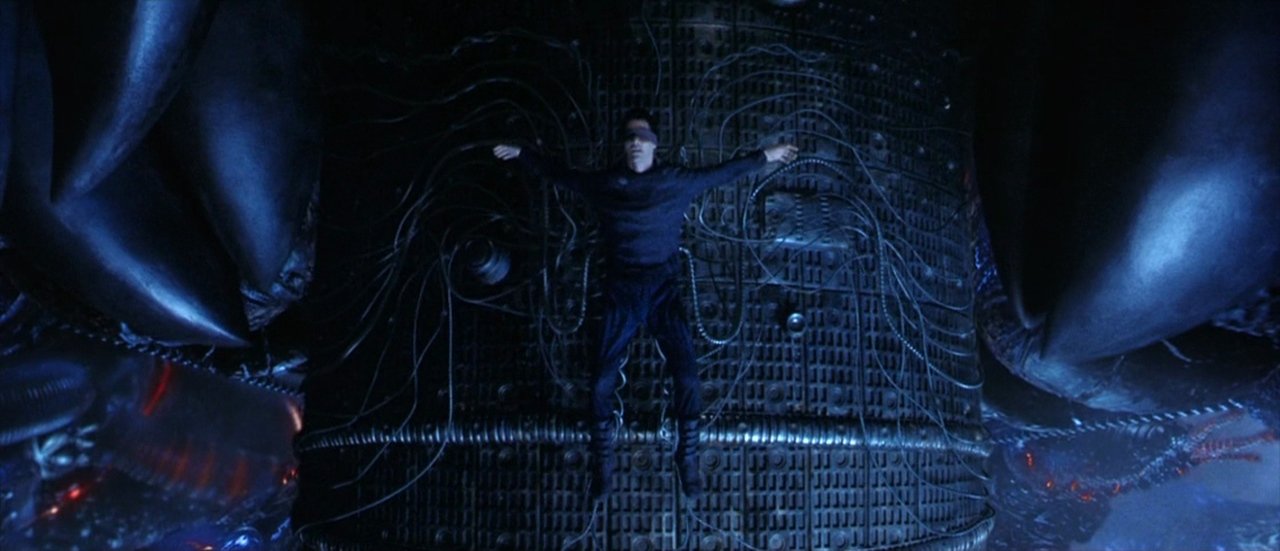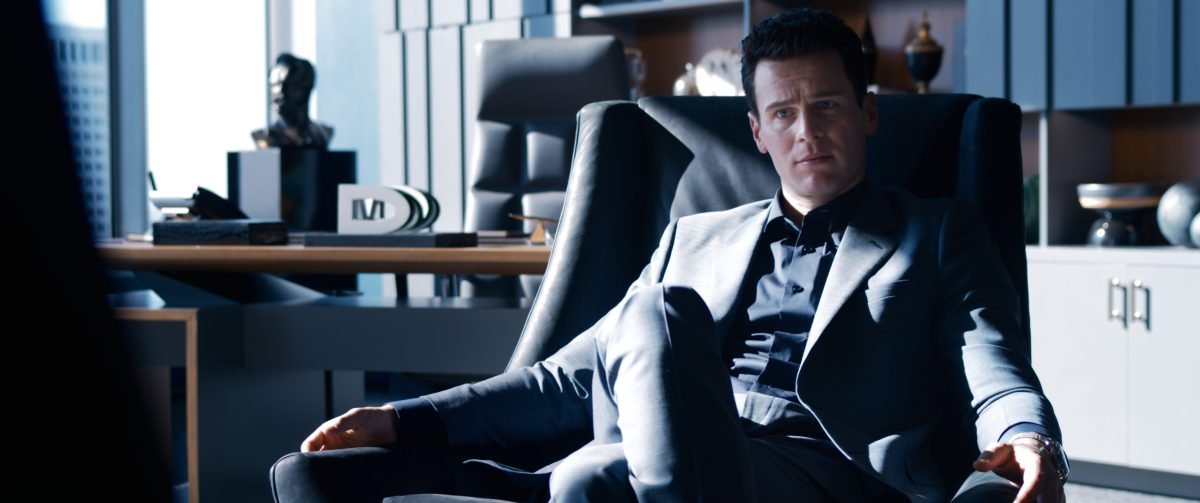The People v. ‘The Matrix Resurrections’
“Have you ever had a dream, Neo, that you were so sure was real? What if you were unable to wake from that dream? How would you know the difference between the dream world and the real world?”
My buddy, Luis, texted me that The Matrix Resurrections is Lana Wachowski’s art therapy film. I thought that was a beautiful sentiment. That was the seed that helped me write this monograph so, Luis, thank you. This one is for you and the other Matrix fans out there. Now, when I started writing this at an ungodly hour of the night, it occurred to me that the one thing that all my monographs have in common is that I defend a lot of critically divisive sequels. I promise. That’s not on purpose but…I can’t say that it will be the last. In fact, my next monograph will also defend a critically divisive sequel.
A visual representation of people's response when I defend ‘The Matrix’ sequels.
There were two weird movie trends in the late 1990s and early 2000s. Fight Club, Being John Malkovich, and Office Space featured protagonists who were white guys who worked in corporate America, bored out their fucking minds, feeling like they were destined for something greater. The other movie trend was white guys feeling like the world they were living in was some sort of artificial creation. Dark City, The Thirteenth Floor, The Truman Show, Memento, Fight Club again explored this concept in one way or another. The white stability of the 1990s caused people to have existential crises, to question their reality, God, their purpose in their life, and whatever the fuck else. The Matrix took these two concepts, threw them both in a stew of other influences, and blew everyone’s minds in 1999. Or should I say freed everyone’s minds? God, I hate myself.
This is the most 90s moment ever committed to celluloid.
The Matrix is the story of a hacker, Thomas Anderson, discovering that he lives in a computer simulation created by machines to use humans as a power source and becomes the messianic figure, Neo. The One. It wasn’t just another film that explored the monotony of working in corporate America. It was a film that featured some of the best action in cinema. It was a film that people interpreted in a lot of different ways. For some, it was a live-action anime (The Wachowskis owe a great debt to the anime classic, Ghost in the Shell, from its aesthetic to its philosophical musings). For others, it was an excellent execution of Joseph Campbell’s Hero’s Journey; the new Star Wars. For philosophers, it explored The Allegory of the Cave and The Brain in Vat scenario. For me, it was a movie that led to a passionate obsession that was very unhealthy for a seven-year-old. When my parents rented it from Blockbuster, I watched it every day until they returned it. Me and my brother would do fake kung fu moves and practice bullet time.
I could never do it. Believe me. I’ve tried.
For Lana and Lilly Wachowski, it was a film that was a cathartic interpretation of their transgender experiences. It incorporates religion, martial arts films, comic books, westerns, and whatever else to tell the story of Thomas Anderson. Neo. The movie that showed The Wachowskis, Laurence Fishburne, Carrie Anne-Moss, and Keanu Reeves were bad motherfuckers.
They call her Trinity cause she’ll introduce you to The Father, The Son, and The Holy Spirit real quick.
“I really should thank you after all. It was, after all, it was your life that taught me the purpose of all life. The purpose of life is to end.”
Of course, when a movie is critically acclaimed and makes a shit ton of money at the box office, the studios immediately want a sequel. The bar was set high. The Matrix Reloaded and The Matrix Revolutions were released in 2003 six months apart. While they were financially successful, the films were met with mixed reviews. People praised the actions sequences but criticized the film's exposition and the further exploration into the philosophy that was established in the first movie. The films were considered over-indulgent, pretentious, and underwhelming. The rollout was also criticized. The Wachowskis tried something ambitious: To weave a multimedia tapestry to chronicle the history of The Matrix Universe (Cyberverse? Metaverse?); an immersive experience that makes the universe as fully realized as Star Wars or Tolkein’s Middle Earth.
People didn’t like needing a syllabus to understand The Matrix films. This is actually referenced by one of the characters in The Matrix Resurrections. Lana and Lilly Wachowski wrote and directed the video game, Enter the Matrix also released in 2003. The game follows Niobe (Jada Pinkett-Smith) and Ghost (Anthony Wong) in a story that parallels events in the two sequels. The players got to do all the incredible things in The Matrix they saw their favorite characters do. I can’t even tell you how many times I played this game. I think it’s the reason why I was so shitty in school. Why learn about acute angles when you can bullet time in a video game? In that game, I knew kung fu; if that is not a great representation of The Matrix, I don’t know what is. Seriously, that game fucking slaps. The Wachowskis were also involved in The Animatrix, a collection of anime films that told the origins of the war with the machines and explored the universe from various points of view. Hell, Samsung even released a phone to promote the movie. This was considered a multimedia cash-in but the Wachowskis were ahead of their time because it is one of the most ambitious attempts at immersive storytelling in cinema history.
In anticipation of the fourth Matrix film, people revisited the Matrix sequels and discovered they really aren’t as bad as people remember. As I got older, I started to hate The Matrix sequels; agreeing with the reviews at the film’s release. I also thought cartoon Neo looked really fucking stupid. Seriously. Looks like a video game. A video game. Huh. What is The Matrix? But upon revisiting them, I reached a new conclusion: This is one of the most accomplished movie trilogies Hollywood has ever released.
At least it’s a PS4 video game.
Please stop yelling at me. What are most people’s complaints? The sequels rely too much on exposition. Well…so does the first one. The characters spend too much time talking about their philosophical musings. Well…so does the first one. That weird rave slo-mo sex scene goes on for way too long. Okay. I’ll give you that one. But there is a lot of merit to this film. They have some of the most impressive action sequences of any modern blockbuster. The films don’t talk down to the audience but challenge their intellect. They expand on the world and Neo’s path reaches its logical conclusion.
The sequels explore Neo’s struggle with being “The One.” In The Matrix itself, he’s a superhero, in the real world, he’s just a man. The citizens of Zion ask him to save their loved ones from The Matrix and all he can do is say that he will try, unsure if he will be able to. He’s trying to understand his purpose.
That’s what the sequels explore. What does it mean to have a purpose? If our purpose is dictated to us by others, do we really have free will? How is that different than being plugged into The Matrix? In the first film, Neo says he doesn’t believe in fate because he doesn’t like the idea of not being in control of his life. In the climax of The Matrix Reloaded, the creator of The Matrix, The Architect, gives Neo a choice: Go to the source of the machines and reboot The Matrix while they destroy Zion, or save Trinity who will die if he goes to the source. This is the sixth version of The Matrix and Neo’s predecessors all chose to reboot Zion. But Neo exercises his free will and saves Trinity.
This guy is dressed like a chicken tycoon.
While Neo believes in free will, his former enemy Smith (Hugo Weaving) believes his ability to become a rogue program in The Matrix after Neo killed him has given them both a purpose that binds them together. Smith is now a virus and copies himself onto every human and program in The Matrix. The Oracle tells Neo that Smith is his opposite; a negative equation in The Matrix created to balance the power of The One. They both have equal power and Neo has to go to Machine City to the source to work with the machines to defeat Smith, who is now emoting like a human; a being feeling more fulfilled now that he’s found his purpose. Neo and Trinity fly to Machine City. On the way, Trinity flies up over the polluted skies and sees the sunlight. Unfortunately, they crash and she dies. It’s very heartbreaking to watch Neo cry, holding Trinity as she passes away. She was the one who believed in his role as The One. Now he has to go to Machine City alone, negotiate peace, and form an alliance with the machines to face Smith. They engage in an apocalyptic showdown in a thunderstorm. It’s a fucking Dragonball Z fight. It’s awesome. God versus Devil. Free will versus purpose.
This scene is too fire.
When Neo is on the verge of being defeated, Smith asks him why he keeps going. Neo replies, “Because I choose to.” He chooses to fight even though it’s futile. Neo has finally embodied free will. Smith copies himself onto Neo and the machines electrocute Neo’s body in the real world. Smith is defeated and The Matrix is rebooted, now improved. Neo has saved everyone.
Neo is now The Messiah.
When the films were released after making a shit ton of money, The Wachowskis said they had no intention of making any more Matrix films.
Until…
“I have to say I’m kind of excited. After all these years, to be going back to where it all started. Back to The Matrix!”
The Matrix Resurrections was released on December 22, 2021, in theaters and HBO MAX. Critical reception was mixed. Some thought the film was too meta. Others thought that it was a heartless rehashing of an established IP that uses nostalgia for a cash grab; a film that was so bad due to its poor screenplay and poorly executed visuals. I’ll give you the visuals because the film lacks the precision of the previous films. The visuals of the previous films were crafted precisely to the edit and the film suffers from Wachowski’s looser approach. Others felt it was an earnest film that was a welcome entry in a very ambitious series. I fall into the latter category.
Also, my man, Yahya, is dripping in this movie. Literally.
For the past ten years, Hollywood has been taking advantage of our nostalgia and making a shit ton of guap. Sometimes the films have been good, others not so much. But when the market is oversaturated with heartless films based on established IP, The Matrix Resurrections is a revelation; a very personal film to writer and director, Lana Wachowski.
You’ll notice that only one of The Wachowskis returned for the fourth installment. Their parents died and they coped with it very differently. For Lana, it was a cathartic way for her to deal with her parents’ death.
When asked about the origins of the film, Lana said, “I couldn’t have my mom and dad… yet suddenly I had Neo and Trinity, arguably the two most important characters in my life. It was immediately comforting to have these two characters alive again, and it’s super simple. You can look at it and say: “Okay, these two people die, and okay, bring these two people back to life, and oh, doesn’t that feel good?” Yeah, it did! It’s simple, and this is what art does and this is what stories do. They comfort us and they’re important.”
Lilly said, “There was something about the idea of going backward and being a part of something that I had done before that was expressly unappealing. And, like, I didn’t want to have gone through my transition and gone through this massive upheaval in my life, the sense of loss from my mom and dad, to want to go back to something that I had done before, and sort of walk over old paths that I had walked in, felt emotionally unfulfilling, and really the opposite — like I was going to go back and live in these old shoes, in a way. And I didn’t want to do that.”
So, with that in mind, Neo and Trinity’s return in this film can be interpreted in two ways: The Afterlife or reincarnation. Neo and Trinity (Now Thomas Anderson and Tiffany are in a new Matrix; a purgatory of sorts where neither knows of their past life. They’re both strangers stuck in a monotonous existence that seems to play in a loop.
“Why can’t I age?”
Neo, once again Thomas Anderson, is the world’s most famous video game developer. He’s created the most successful video game franchise of all time: The Matrix Trilogy. This is the meta stuff that people couldn’t get behind. This isn’t a tactic used to capitalize on people’s nostalgia but a deliberate storytelling device that is a metaphor for Wachowski’s experience. Thomas being a video game developer is analogous to Wachowski’s perspective of being a filmmaker that created one of the most influential pop culture phenomena. Neo has to make a sequel before Warner Bros. does it themselves. I mean the actual Warner Bros. They name-drop them and everything. This point is driven home when Thomas says to Tiffany that there is a lot of him in his games.
Thomas is going through a mid-life crisis. He tried to commit suicide by jumping off a building believing he can fly. He has a business partner, Smith (Jonathan Groff), who like Thomas, can’t remember his previous life as Neo’s nemesis. He’s having a lot of flashbacks; one of the criticisms of the film. People disagreed with this approach; believing that Wachowski didn’t trust her audience but these flashbacks are Thomas's memories trying to fight through so he can remember who he really is. These flashbacks and suicide attempts are the reason Thomas is in therapy; a patient of The Analyst (Neil Patrick Harris), a program that prescribes him blue pills to keep him in The Matrix.
This guy is a little too loose with the prescription pad.
He’s clearly going through depression; drinking, reenacting martial arts moves and staying up late scrolling through his phone. In fact, everyone in The Matrix can’t stay off their devices. It’s a Matrix that mirrors our own; a reality we can shape online from social media to the metaverse. Ha. Get it? Metaverse? This movie’s meta.
When Thomas unplugs from The Matrix and becomes Neo again, he meets Niobe, now 60 years older. She informs him a new war has been waging since he sacrificed his life; one in which the machines fight each other and have formed an alliance with humans. Neo is essentially a spirit; witnessing how the world changed since his death. He finds his new purpose: Love. Neo decides to go back into The Matrix to rescue Trinity. However, he’s not the Neo he once was. He doesn’t have access to his powers. However, he can now do The Kamehameha.
Kame…hame…HAAAAA!
When he enters The Matrix again, The Analyst reveals to Neo that he has taken over The Architect as the creator and the head of the new Matrix. In this Matrix, The Analyst has created a reality that humans feel comfortable in. They no longer feel the need to unplug. Also in this Matrix, Neo and Trinity’s yearning for each other produces a lot of energy for the machines; a plan The Analyst put into motion shortly after Neo and Trinity died.
Neo makes a deal with The Analyst: If he can’t make Trinity remember their past then he will replug back into The Matrix. Smith enters the picture to disrupt everything. See, he has a new purpose too: Hate; Smith, again, the complete opposite of Neo. His hatred for Neo and The Analyst are the only things that give him fulfillment.
“When you’re gone, I’ll go mad. So don’t throw away this thing we had.”
Despite this, Neo is successful and he and Trinity escape (Carrie Anne-Moss really fucks people up) on a motorcycle and find themselves on a roof. Trinity looks at the sun in a heavenly glow that recalls the scene before her death in Revolutions. They leap off the roof hand in hand in hope that Neo will fly. Instead, Trinity is able to fly, and the two escape into the heavens.
Neo and Trinity fly toward the sun before her death.
Neo and Trinity before they fly toward the sun and become The One.
Resurrections has turned the series into a love story. The first three are about the romance between two people till death parted them and Resurrections is about how those two people found each other in the afterlife. It’s reminiscent of a film my significant other showed me, What Dreams May Come starring Robin Williams; a film about a man who goes to Heaven after his death but embarks on a journey to Hell to reunite with his wife. A film earnest in its meditation on love, the afterlife, and reincarnation. The film gets its title from a line in Hamlet. “For in that sleep of death, what dreams may come.” Something that holds equal sentiment in The Matrix Resurrections.
The final image is Neo and Trinity, both with the power of The One, holding hands, flying like two angels in the sky; perhaps translating Lana Wachowski’s image of her parents in the afterlife.
When I watched the film I couldn’t help but think of something Keanu Reeves said on The Late Show. Keanu has also gone through his hardships. He’s gone through the deaths of his daughter and his significant other. Colbert cheekily asks him, “What do you think happens when we die, Keanu Reeves?” Keanu takes a moment and says:
“I know that the ones who love us will miss us.”


